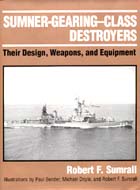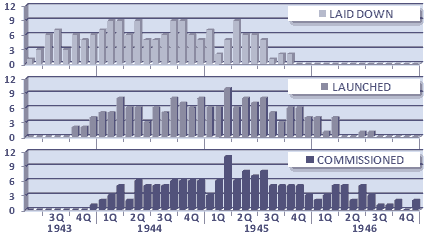

A comprehensive look at Sumner-Gearing-Class Destroyers: Their Design, Weapons, and Equipment by Robert F. Sumrall.
Even before construction of the preceding Fletcher class commenced, the Navy was considering a design that could accommodate such increased armament. Impetus for the new design appeared in 1940, when a report on Gleaves’ sea trials called for reduced silhouette and topweight forward in future construction, e.g., “by substituting a twin 5-inch mount on the forecastle in lieu of the two forward single 5-inch mounts.” There followed a reassessment of the “distribution of the total weight of the armament, as between torpedoes, 5-inch guns, depth charges, and close-in AA defense . . . to disperse the risks of damage and minimize the ill effects of any single hit and gain maximum sectors of effective fire.”
In September 1941, with the first Fletchers already laid down, six new designs were proposed utilizing the same 2,100-ton displacement. Bureau of Ships’ recommendation looked ahead to future “improvements in antiaircraft fire which the introduction of radar promises. If air targets can be brought under effective fire by 5-inch guns early, the provision of four such guns on the forecastle becomes increasingly attractive.”

168 Allen M. Sumners and Gearings were delivered, the last one in 1952.
In early 1942, conferences held under Chief of Naval Operations Adm. Ernest J. King affirmed that forward firepower was “by all means the most desirable main battery for a destroyer of this size” with the No. 3 5-inch mount capable of firing directly forward over the mast at long range. This concept, which the basic ten-tube Fletcher design could accommodate with only slight increases in beam and displacement, became the DD 692 class—the Allen M. Sumners—and its extended-hull variant, the DD 710 class—the Gearings. Collectively, these were known as 2,200-tonners, with the two classes initially differentiated as “short hulls” and “long hulls.”
CONSTRUCTION
Previous. The pace of US destroyer construction peaked in 1944 and early 1945 with the Allen M. Sumner-class 2,200-tonners. The 40 Sumners delivered through September 1944 were launched an average of 144 days after keel laying and commissioned after an average of 88 days more, or 232 days total—less than 2/3 the elapsed time for the average Fletcher.
As the end of the war approached, construction slowed so that the corresponding averages through the end of World War II relaxed to 167, 97 and 264 days respectively. The final seven Gearings were commissioned after 1946 and do not show on the bottom chart.
In 1943, selected yards began changing over production from Fletchers to Sumners; likewise in 1944, Sumners were superseded on the ways by Gearings. By VJ Day, exactly 100 ships of these new classes—55 Sumners and 45 Gearings—plus an additional 12 Robert H. Smith-class light minelayers, had been placed in commission.
Eventually, 168 2,200-tonners were completed. All their keels were laid by the end of 1945 and all those that were not broken up on the ways were launched by mid-1946. All except seven ships were delivered by the end of 1946.
The last Gearing, Timmerman, was not placed into commission until 1952.
Sources: Friedman, Reilly, Sumrall, Whitley.